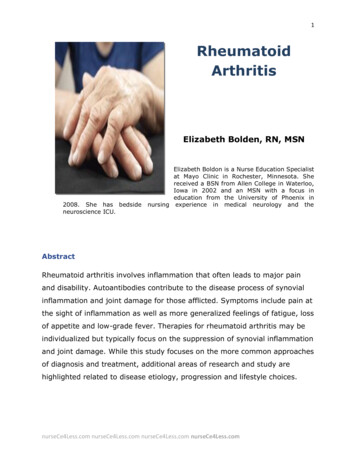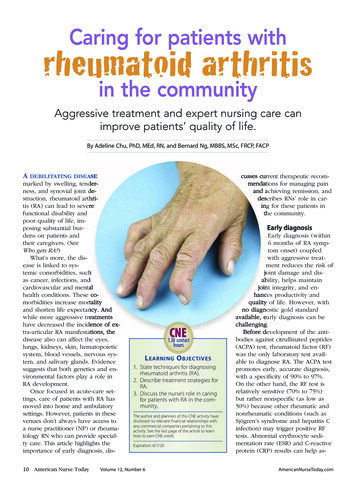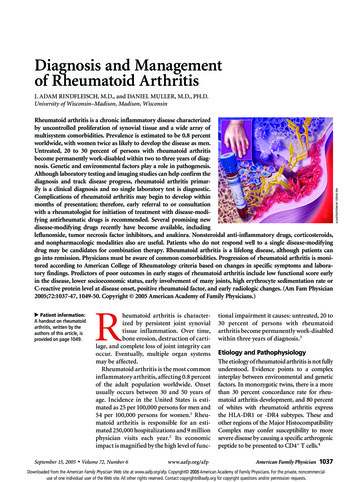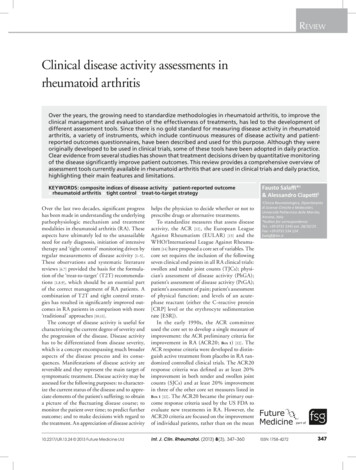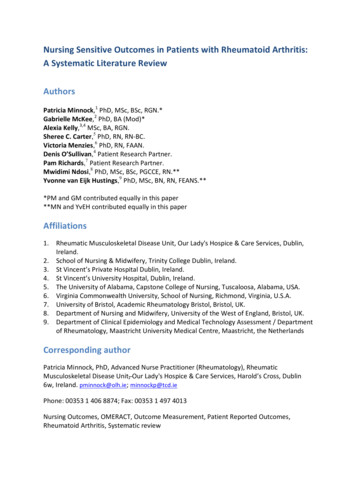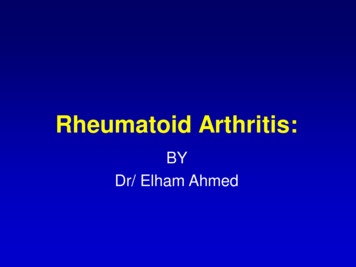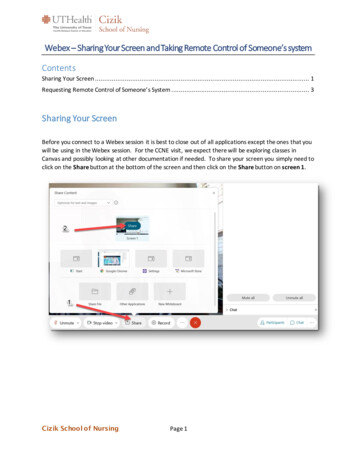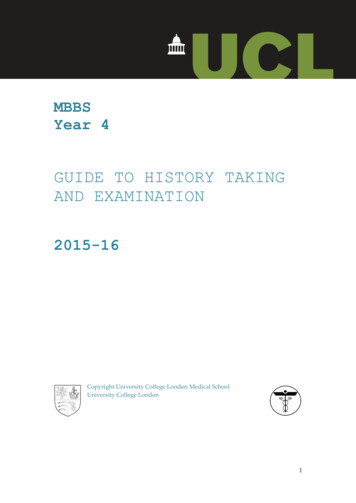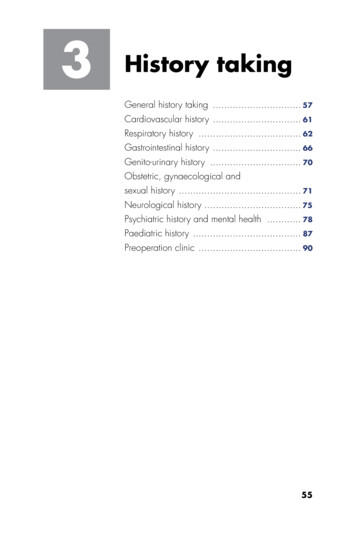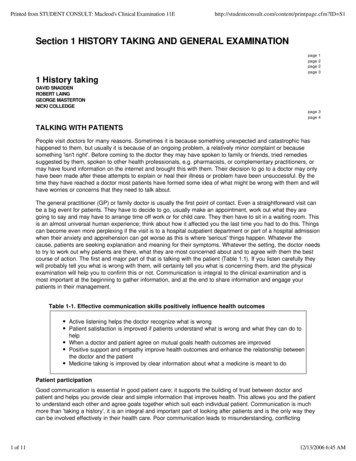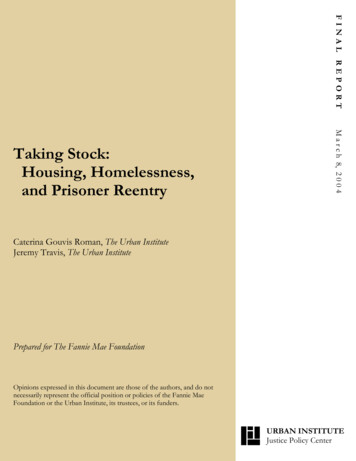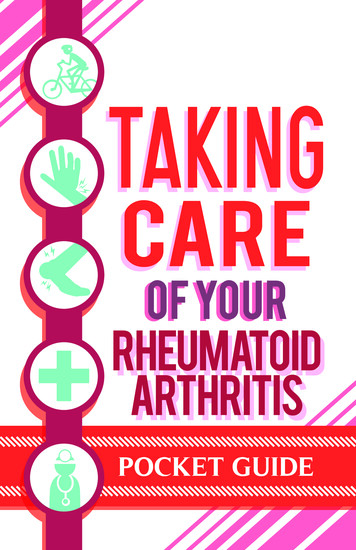
Transcription
TAKINGCAREof yourPOCKET GUIDE
TAKING CARE OF YOURRHEUMATOID ARTHRITISUse this guide1TABLE of CONTENTSDEFINITIONS AND DIAGNOSIS6 MY CONTACTS8for info on caring for rheumatoidarthritis, to organize your dataand as a quick resource.RA MYTHBUSTING9 MY TREATMENT PLAN1 3 MANAGING MEDICATIONS1 5 DAILY MEDICINE SCHEDULE1 7 WHEN SURGERY IS NEEDED1 8 FIGHTING FATIGUE19STAYING ACTIVE2 2 MY EXERCISE CHART2 4 RA AND NUTRITION2 6 MY HEALTHY SHOPPING LIST2 7 COPING AND SUPPORT2 9 DEALING WITH DEPRESSION3 0 THE FUTURE OF RA RESEARCH31NOTESRESOURCESDISCLAIMER. This book provides general information aboutrheumatoid arthritis and related issues. The information does notconstitute medical advice and is not intended to be used for thediagnosis or treatment of a health problem or as a substitute forconsulting with a licensed health professional. Consult with a qualifiedphysician or health care practitioner to discuss specific individual issuesor health needs and to professionally address personal medical concerns.
DEFINITIONS AND DIAGNOSISWHAT IS RHEUMATOID ARTHRITIS (RA)?RA is a chronic (long lasting) health issue that affects the smalljoints in the hands and feet, causing pain and swelling. Thedisease can progress and cause deformity and stiffness in thehands, wrists, fingers, feet and ankles.Anyone can get RA. It seems to affect women more than men,starting in middle age and is common in older adults. Cases of RAin children and young adults are rare but possible.RA BYBY THETHE NUMBERSNUMBERSRA0.5% -1%Approximatepercentage of adultswith RA throughoutthe world2-3Number of timesmore likely a womanwill develop RA overa man45-65Peak ageof RAonsetRA Q & AQ: What causes RA?Doctors don’t reallythe exact causes.A: knowWith this type ofarthritis, a person’s bodytissues are attackedby his or her immunesystem. Researchersdon’t quite know howand why this happensbut are learning moreall of the time. Thereis hope for a cure orprevention in the future.Possible causes for RA:Genes (passed to achild from a parent)EnvironmentHormones1
RA DEFINEDRheumatologist A doctor who specializes in problems ofthe joints, bones and muscles.RISK FACTORSSexWomen are more likelyto develop RA.AgeWhile RA can occur atany age, it commonlystarts bet ween the agesof 40 and 60.Family historyIf a member of your familyhas RA, your risk of thedisease may be greater.DIAGNOSISDIAGNOSISYo u r fa m i l y d o c t o r o rrheumatologist can diagnoseRA. This can often be hardto do because there isn’t ast a ndard test for RA. T hesymptoms may be similar toother joint diseases and maytake time to develop in full. Inorder to diagnose the disease,your doctors will use:Your medical historyA physical examX-raysLab testsUnlike other forms of arthritis, RA affects the lining of thejoints. The result is painful swelling that can lead to worndown bones and deformed joints. In time, permanent damageto the joints may take place.SIGNS AND SYMPTOMSFatigueJoint painand tendernessJoint swelling2Joint rednessFeverJoint warmthJoint stiffness,worse in themorningF i r m ti s s uebumps underthe s ki n o fthe armsWeight lossEarly RA diagnosis and treatment can lessen the riskof permanent joint damage.
RA REVEALEDRA is a risk factor for heart attacks. Those with active RA,even those without high cholesterol, high blood pressure ordiabetes are two to three times more at risk for heart attack.WHAT TOWATCH FORRA increases yourrisk of developing:Osteoporosis: Along withsome meds used to treat it,RA can increase your risk ofosteoporosis. This conditionweakens bones and makesthem more likely to fracture.Carpal tunnel syndrome: Ifyour RA affects the wrists,the swelling can squeeze thenerve that serves most of yourhand and fingers.Heart problems: RA canincrease your risk of hardenedand blocked arteries, as wellas swelling of the sac thatsurrounds the heart.RA BYBYRATHETHENUMBERSNUMBERS2.5Percentage of increasein RA cases in womenbetween 1995 and2007, according toMayo Clinic research.Rates of RA casesamong men duringthat time actuallydropped.Lung disease: Those withRA have a greater risk ofswelling and scarring of thelung tissues. This can lead toshortness of breath and otherbreathing difficulties.FIND OUT MOREHealthline:What Do You Want to Know About Rheumatoid is3
YOUR FIRST DOCTOR VISITIf you think you may be suffering from RA, schedulean appointment with your doctor. Fill out this formand take it with you to the visit.Detailed description of symptoms:Past medical problems:Medical problems of parents or siblings:4
Medications and dietary supplements taken:Questions to ask the doctor:Be ready to answer these questions your doctor may ask you:When did your symptomsDoes any activity make yourbegin?symptoms better or worse?Have your symptomsAre your symptomschanged over time?interfering with daily tasks?Which joints are affected?During the exam, yourdoctor will check:Blood testsA blood test may showt h e p re s e n c e o f a ninflammatory process inthe body, as well as lookYour reflexesfor certain antibodies.Antibody tests show upYour muscle strengthnegative in 20 percentof cases.X-raysX-rays can help track the progressionof RA in your joints over time.Joints for swelling,redness and warmthFIND OUT MOREWebMD: Diagnosing Rheumatoid nosing-ra5
CONTACTSMYCONTACTSMYEmergency ContactsEmergency response: 911Name:Relationship:Cell Phone: ()Home Phone: ()Name:Relationship:Cell Phone: ()Home Phone: ()MedicalMy General or Family Doctor:Phone: ( )Rheumatologist:Phone: ()Other specialist:Phone: ()Hospital:Phone: ()Health Insurance Provider:Phone:()Website:Case Manager:6Phone: ()
MYCONTACTSCONTACTSMYOther Professional ContactsName:Service/Function:Phone: ()Name:Service/Function:Phone: ()Name:Service/Function:Phone: ()Family MembersName:Phone: ()Name:Phone: ()Name:Phone: ()Name:Phone: ()Name:Phone: ()7
RAAMMYTHBUYT H BUSSTINGTINGRRA MYTHBUSTED!Rheumatoidarthritis is thesame as regulararthritis.RA is a chronic, progressive autoimmunedisorder. Osteoarthritis–what we consider“regular arthritis”–is caused by injury toaging joints. With RA, the body makesantibodies that attack its own tissues.These attacks are known as flare-ups.Only old peopleget RA.The disease begins between the ages of 30and 55 for most people with RA. It’s the peakgroup, but anyone can get RA.Most people withRA end up in awheelchair ornursing home dueto the disease.RA can be different for different people.Most will go on to live independently. Thedisease can progress and cause disability,but most people with RA these days do wellwith staying mobile and on their own.RA isn’t thatserious of adisease.If it’s not treated in the right way, RA can bea threat to your health and mobility. Whendiagnosed quickly, a regular treatment plan canprotect the joints from further injury. Long-termfunction and mobility for years to come is morelikely for those who don’t wait to get treatment.Having RA meansyou can’t work.You may need to change or adapt somework tasks, but an RA diagnosis doesn’tequal lifetime disability. You may have tolimit activities during flare-ups but mostpeople with RA continue to work.Most people withRA get cancer,too.Those with RA are at slightly higher riskfor developing lymphoma, but the overallrisk is low.Rest is best forpainful, stiffjoints forthose withRA.Joints feeling the pain and tightness ofRA need stretching and exercise. Doctorsencourage physical activity to keep jointsmobile. While rest is necessary, people withRA should be moving more, not less.8
MY TREATMENT PLAN !TREATMENT BASICSWhen it comes to treatment plans for RA, doctors have manyoptions. Educating yourself is the first step in taking care of yourRA. With your health care team you’ll be able to learn about:Treatment optionsHow to talk toyour doctorsTypes of exercises to doProblem-solvingRelaxation and stressrelief techniquesSupport groupsEducation programs will help you learn about RA, lessen thepain, cope with the physical demands and the emotions, feelmore in control and become more confident.The goals of treatment are to:Reduce the painHelp people feel betterBring down swellingHelp people stay activeStop or slow down damage to the jointsThe overall goal is of course to lead a full and active life. Knowyour disease. Know your treatment plans. Know yourself. It alladds up to a better life.TREATMENT OPTIONSTREATMENTLifestyle changesA harsh reality of living with RA is the fact that you’re goingto have to make some changes to everyday routines in order tocope with the demands of the disease.Work exercise into your daily routineGet enough restTake care of your jointsFind ways to lower stressFocus on eating a healthy dietIf these things have not been part of your lifestyle, itwill be necessary to change your routine and makethem a priority each day.9
MedicineThere is no cure for RA. Medications can ease the swelling inyour joints. This will lessen pain and stop or slow down anydamage to the joints. A lot of drugs that treat RA can haveserious side effects. Doctors will most often first prescribemeds with the fewest side effects. You may need stronger drugsor a mixture if your condition gets worse. See the MANAGINGMEDICATIONS SECTION for more details.SurgeryPeople suffering from severe joint damage may seek out one ofmany kinds of surgeries. Surgery is used to:Lessen the painHelp an affected joint work betterMake daily activities possible againKnow that surgery is not always the best treatment method. You mayor may not be a candidate for surgery. Only your doctor can makethat determination. Talk with him or her about surgery options.Regular doctor visitsSeeing your doctor on a regular basis will help track theprogress of the disease. Doctors can also watch for side effectsand change treatment when it’s needed. Your visits may includex-rays, blood, urine and other lab tests to fully diagnose andassign proper care for the disease.RA REVEALEDSmoking may trigger RA. Research has shown that smokingcan play a part in as many as a third of all severe RA cases.10
EXPLORING THE ALTERNATIVESSome people use special diets, vitamins and supplements or otheralternatives to treat their RA.Medication prescribed by your doctors is the best way to battleRA. While alternative therapies to augment regular RA treatmentmay not be well tested or proven to be affective, many of thesenatural ways help people ease stress. Always talk with your doctorbefore starting an alternative treatment program.These other therapies may benefit you.RA causes you to use your joints in ways thatEXERCISEadd stress to other body parts. Therefore, it isimportant to stay flexible and strong with regularexercise.PHYSICALTHERAPYPhysical therapy may help heal and strengthena body part weakened by RA, or an area that’scausing you problems. To ease swelling and getpeople back in shape, physical therapists use:HeatElectrical stimulationIceRange-of-motion exercisesStrengthening movesThis short-term plan might have you going fortreatment a few times a week for a few weeksuntil you feel better.OCCUPATIONALTHERAPYOccupational therapists help patients figure outproblem areas during daily activities. They thencome up with plans of action to deal with theseproblems. These therapists can modify your workarea and habits in order to deal with pain anddiscomfort and to avoid injuries.MIND-BODYTHERAPIESCOUNSELINGThese therapies help you use your mind to makeyour body feel better. Meditation, biofeedback,breathing exercises, and guided relaxation, aswell as exercises such as yoga and tai chi canhelp you focus your mind. This is often helpfulwhen coping with pain, and can make strengthand flexibility better.Behavioral psychotherapy can help peopleidentify problems in the way they think and act.It encourages them to change their behavior andcan be helpful for those with RA who sufferfrom depression. Counseling can also help youcope with the daily stresses of chronic illness.11
EXPLORING THE ALTERNATIVESis one of the best and most basic home curesHOT AND COLD Heatfor RA relief. A hot bath or shower can help relaxTREATMENTSyou and soothe joint and muscle pain. Alternatinghot packs with cold packs can give you quick andlasting relief. A member of your health team canteach you how to use heat and cold safely.ACUPUNCTUREThis is the ancient Eastern healing art ofstimulating points in the body by sticking in thinneedles and leaving them in place for a while.Only a few studies have shown that acupuncturecan help with RA symptoms. Many people swearby it. Unless the thought of needles piercing yourskin bothers you, it might be worth a try.RESTIf you have RA, it’s crucial that you don’t do toomuch. Take a rest whenever you need it. Pushingyourself too hard will make the fatigue even worse.MY TREATMENT PLAN WILL INCLUDE:FIND OUT MORENIH: Rheumatoid Arthritis andComplementary Health 2
MANAGING MEDICATIONSMost people with RA take some form of medication to treat thedisease. These drugs are used to:Take away painLessen the swellingStop the disease from getting worseRARA MEDICATIONS CHARTWHAT THEY ARE WHAT THEY DOSIDE EFFECTSNSAIDsNonsteroidalanti-inflammatorydrugs (ibuprofen,naproxen sodium)Take away painEase swellingRinging in the earsStomach irritationHeart problemsLiver and kidneydamageSteroidsCorticosteroidmedications suchas prednisoneReduceinflammation andpainSlow jointdamageThinning of bonesWeight rugs (methotrexateand others)Slow theprogress of RASave joints andother tissuesfrom permanentdamageLiver damageBone marrowsuppressionBiologic agents(A newer class ofDMARDs)Target parts ofthe immunesystem that triggerinflammation thatcause joint andtissue damageLiver damageBone marrowsuppression13
Your doctor will determine whatdrugs to prescribe based on:Your general healthHow serious your RA isHow serious your RA may b
rheumatoid arthritis and related issues. The information does not constitute medical advice and is not intended to be used for the diagnosis or treatment of a health problem or as a substitute for consulting with a licensed health professional. Consult with a qualified physician or health care practitioner to discuss specific individual issues
